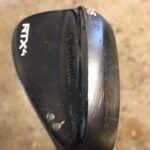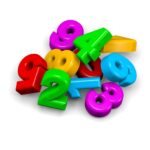My current wedge set is somewhat particular. I have a 46 degree Titleist instead of my set pitching wedge for the versatility it provides. My gap wedge has become a chipper for reasons I highlighted in this article. I have gone into exactly why i currently have ‘just’ a 56 sandwedge rather than a lob wedge here too. However, I am an incorrigible tinkerer with my clubs and I think that I might be missing a trick by not having a 54-degree wedge in my bag.
Versatility vs Speciality
Although I wouldn’t consider myself to be a particularly strong wedge player, it is an area of the game that I find fascinating for the simple reason that there are so many ways to look at it and so many variables that could potentially come into play. Here are a couple of non-exhaustive lists for starters:
Technical considerations:
- bounce
- grind
- loft
- offset
- length
- grip size
- sole width
- weight
- As if that weren’t enough, what are when we look at what we might consider the non-technical stuff:
- course conditions
- season
- sand type/quality
- weather
- links/inland
- green speed
- green size
- rough
- swing speed
- angle of attack
You see what I mean? The permutations are endless. In fact, finding that perfect wedge doesn’t even make sense as a concept when we consider these things. What might be great one day on one course makes no sense at all on a different course in different weather conditions.
Even one change can totally upset the apple cart. For example, I know quite a few golfers who have found that their wedges didn’t work as well as they were used to when their local course changed that hard-packed sand for something nice and fluffy and replaced the rough with bare dirt under the trees.
This is the whole question of specificity vs versatility. It seems to make perfect sense to pick something that works as well as possible for one set of variables but it makes no sense at all if these variables change. Of course, we don’t usually have to carry just one wedge (although I often do) which means that we try to cover as many options as possible with perhaps 2-4 clubs.
Choosing the Right Wedge
Another common thread is to have a few wedges at home and simply pick the options that seem likely to work best on any given day. The downside here is of course that we are never completely familiar with what we play. Different lofts, grinds and general specs mean that we won’t feel as comfortable as if we play the same club all the time. I do actually do this quite a bit, but generally because I like playing different clubs rather than because I feel I am gaining an edge by adjusting grind, loft or whatever.
This brings us on to the idea of simply picking the wedge set up that offers the most bang for your buck. There are quite a few schools of thought here too. For example, I would guess that a 52/56/60 selection might just be the most common throughout golf, from hacker to Tiger. It should give decent gapping, enough loft for any given situation and a reasonable transition from iron set to specialist wedges.
Most golfers will stop here, but you could also look to have various grinds in order to really cover all the bases. Maybe a high bounce 56 with a thicker sole that will be used almost exclusively for getting out of the sand and then a lower bounce 60 for nipping the ball high off the turf and landing soft over an obstacle. Once again, this is very golfer-dependent and more especially dependent on skill level. Having a low bounce 60 for example certainly opens up some doors in terms of shots that can be played, but not if your most likely outcome is a head-high skull across the green!
The 54-Degree: Mr Versatility
This 52/56/60 does make a lot of sense and I have played some pretty decent golf with it. I never really found myself searching for a club I didn’t have, for example. I do think the 54 is actually a better choice for most people though and this is why.
I think the 54 has enough loft to do most jobs that require loft. I don’t necessarily mean the absolute Mickelson lob shot, although you can certainly open the blade right up and fly the ball very high. However, if this is a shot you really need and, more importantly, can play, you might want to put a 58 or 60 in the bag.
I am thinking more about getting up and over things, or hitting that pitch shot which flies most of the way and rolls the last few yards. You might say that the 56 will do this at least as well and this is true, but the 54 has a distinct advantage for most people. Lots of golfers, myself included, struggle with really pinching the ball, hitting down on it and squeezing it out with the hands forward. The sort of swing mechanics that you see on those slow motion swing shots of tour players for example as a beaver pelt divot opens up after the ball.
Most golfers will, at best, have a vertical club shaft at impact. Many will actually have a flip and be adding loft to the club. If this is you, and it probably is, you really don’t want too much loft on the club because you re creating more loft through faulty swing mechanics.
Of course, none of us should just accept this less than perfect swing, but the chances are we won’t get the same degree of shaft lean as the best players in the world. For the wedge game, especially with full shot, this is a potential problem. For example, the 56 actually becomes quite a one-dimensional club. This added loft means that it is hard to get any real distance out of it.
The Full Shot Wedge
You might think that the 56 isn’t a full shot club, but surely it should be. Being able to hit a distance with every club in the bag can be important. Hitting a 54 will just give that little bit more forward momentum, even if you don’t hit down perfectly. Of course, you might follow this logic a bit further and say why not just have a 52, but then you are losing out when you need a club for the bunkers that has a bit of bounce and enough loft to get up and over the lip.
I think I better wedge set up would be something like 48 or 50, then a 54 and possibly a 58 or 60 for some golfers. In fact, I think that even 48/54 would work very well for a lot of people. Whether as part of a 2 wedge set or 3 (even 4) wedges, the 54 could potentially be a real workhorse at the bottom of the bag for most of us. It can do all the short game stuff but is also a genuinely useful full shot club. Using it so often will also breed familiarity which should improve results even more.





